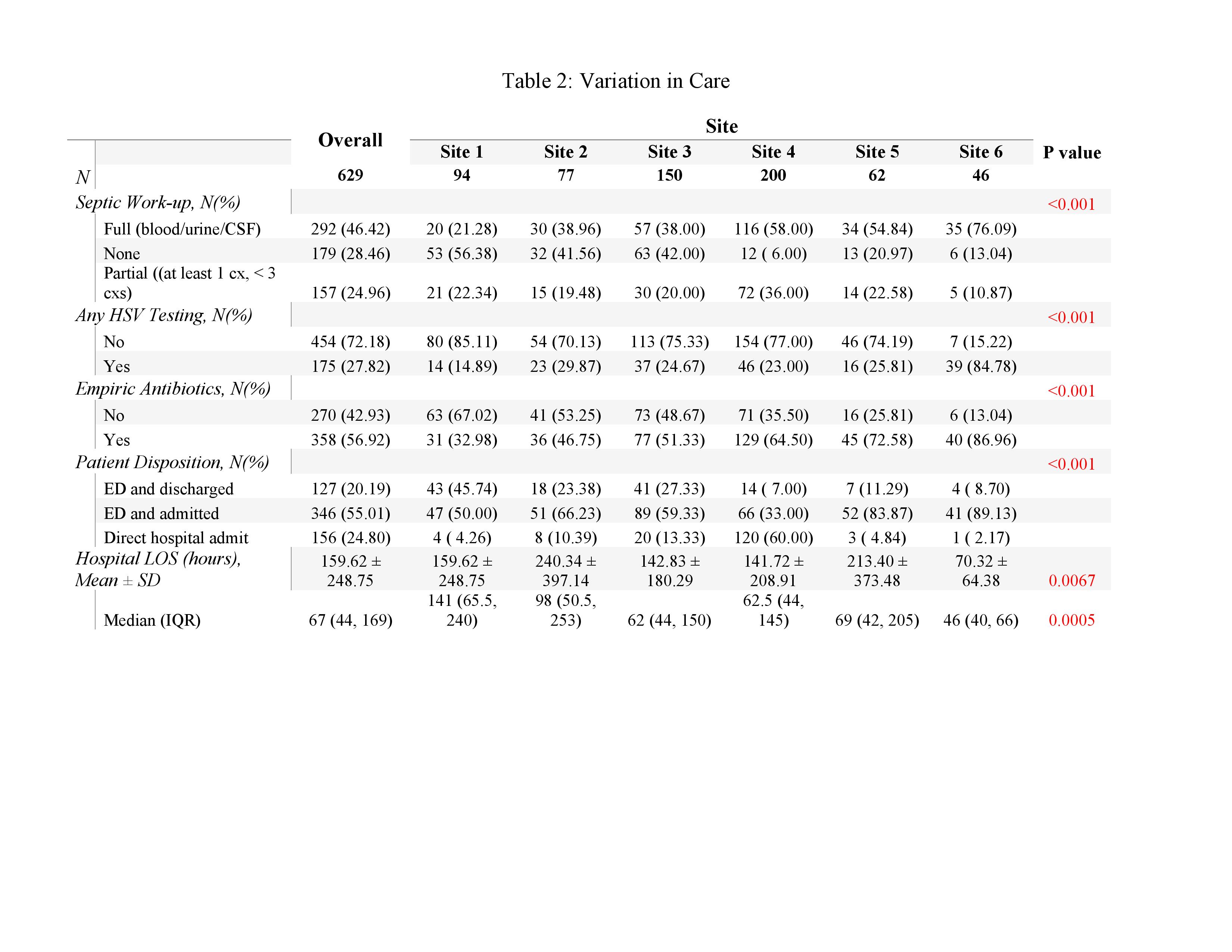Hospital Medicine: Clinical
Category: Abstract Submission
Hospital Medicine: Clinical - Infectious Disease NOS
319 - Variation in Care of Hypothermic Young Infants: A Multicenter Retrospective Study
Saturday, April 23, 2022
3:30 PM - 6:00 PM US MT
Poster Number: 319
Publication Number: 319.213
Publication Number: 319.213
Monica Mattes, Children's Hospital Los Angeles, LOS ANGELES, CA, United States; Meredith Mitchell, Children's Hospital of Richmond at VCU, Richmond, VA, United States; Kira Molas-Torreblanca, Children's Hospital Los Angeles, Los Angeles, CA, United States; Clifton Lee, Virginia Commonwealth University School of Medicine, Richmond, VA, United States; Hania Adib, Children's Hospital Los Angeles, Los Angeles, CA, United States; Elizabeth M. Rinaldi, Children's Hospital Los Angeles, Los Angeles, CA, United States; Amber N. Domako, Virginia Commonwealth University School of Medicine, Richmond, VA, United States; Melissa Burns, Virginia Commonwealth University School of Medicine, Richmond, VA, United States; Jennifer Raffaele, Prisma Health Upstate, University of South Carolina School of Medicine Greenville, Taylors, SC, United States; Meenu Sharma, Children's of Alabama, Birmingham, AL, United States; Stephanie Berger, University of Alabama School of Medicine, Birmingham, AL, United States; John M. Morrison, Johns Hopkins All Children's Hospital, Saint Petersburg, FL, United States; Madhuri Prasad, Johns Hopkins All Children's Hospital, St. Petersburg, FL, United States; Julie K. Wood, Wake Forest School of Medicine of Wake Forest Baptist Medical Center, Winston Salem, NC, United States; Annalise Van Meurs, Doernbecher Children's Hospital at Oregon Health & Science University, Portland, OR, United States; Kathryn Westphal, Pediatrics, Columbus, OH, United States; Vignesh Doraiswamy, Ohio State University College of Medicine, Columbus, OH, United States; Sumeet L. Banker, Columbia University Vagelos College of Physicians and Surgeons, New York, NY, United States; Meghan Gray, NewYork-Presbyterian Morgan Stanley Children's Hospital, New York, NY, United States; Xiyan Tan, Clemson University, Clemson, SC, United States; Nicholas M. Potisek, University of South Carolina School of Medicine Greenville, Greenville, SC, United States; Elizabeth E. Halvorson, Wake Forest School of Medicine of Wake Forest Baptist Medical Center, Winston-Salem, NC, United States; On Behalf of the Hypothermic Young Infant Research Collaborative, University of South Carolina School of Medicine Greenville, Greenville, SC, United States

Monica Combs, MD
Assistant Professor, Hospitalist
Boston Children's Hospital
Boston, Massachusetts, United States
Presenting Author(s)
Background: Numerous decision tools have emerged to help guide management of febrile young infants, but limited data exists to guide the care of young infants presenting with hypothermia.
Objective: Describe the variation in care, specifically in diagnostic work-up, empiric therapies, and patient disposition provided for infants ≤90 days old evaluated for hypothermia in the hospital and/or emergency department (ED) setting between participating sites.
Design/Methods: A retrospective cohort study from September 1, 2016 to May 5, 2021 was conducted across 6 academic medical centers. Eligible patients were identified via billing codes for hypothermia and through a medical record query for an initial temperature documented of ≤36 C within 24 hours of admission. Patients with hypothermia in the NICU or nursery, a central line, known trauma, fever, or inaccessible culture results were excluded. Patient charts were manually reviewed for data extraction. Descriptive statistics were used to characterize the demographics, clinical characteristics, and outcomes of the cohort. For the comparison by site, a p value < 0.05 value was considered statistically significant. Continuous variables were analyzed using ANOVA or Kruskal-Wallis test, while discrete variables were analyzed using Chi-square test.
Results: We identified 629 infants; the majority were < 7 days old, born at >37 weeks gestation, and well-appearing on presentation as demonstrated in Table 1. Most patients (60%) did not have a hypothermia-related billing code. Variation of care between sites is demonstrated in Table 2. Between 21% and 76% of patients at each site had a full sepsis work-up with blood, urine, and cerebrospinal fluid cultures; in contrast between 6% and 56% had no cultures obtained (p < 0.001). Herpes simplex viral testing ranged from 15%-85% between sites (p < 0.001) and empiric antibiotics were administered 33%-87% of the time (p < 0.001). Between 7%-46% of patients were discharged from the ED, while 33%-89% were admitted (p < 0.001). Median hospital length of stay ranged from 46-98 hours (p < 0.001).Conclusion(s): Significant variation in care exists for young infants presenting with hypothermia, and studies only using billing codes may not be representative of this population. Improved understanding of hypothermic young infants and their risk of infection can lead to the development of clinical decision tools to enhance appropriate evaluation and guide management.
Monica Mattes CVCV_MonicaMattesPAS.pdf
Table 2: Variation in Care
Objective: Describe the variation in care, specifically in diagnostic work-up, empiric therapies, and patient disposition provided for infants ≤90 days old evaluated for hypothermia in the hospital and/or emergency department (ED) setting between participating sites.
Design/Methods: A retrospective cohort study from September 1, 2016 to May 5, 2021 was conducted across 6 academic medical centers. Eligible patients were identified via billing codes for hypothermia and through a medical record query for an initial temperature documented of ≤36 C within 24 hours of admission. Patients with hypothermia in the NICU or nursery, a central line, known trauma, fever, or inaccessible culture results were excluded. Patient charts were manually reviewed for data extraction. Descriptive statistics were used to characterize the demographics, clinical characteristics, and outcomes of the cohort. For the comparison by site, a p value < 0.05 value was considered statistically significant. Continuous variables were analyzed using ANOVA or Kruskal-Wallis test, while discrete variables were analyzed using Chi-square test.
Results: We identified 629 infants; the majority were < 7 days old, born at >37 weeks gestation, and well-appearing on presentation as demonstrated in Table 1. Most patients (60%) did not have a hypothermia-related billing code. Variation of care between sites is demonstrated in Table 2. Between 21% and 76% of patients at each site had a full sepsis work-up with blood, urine, and cerebrospinal fluid cultures; in contrast between 6% and 56% had no cultures obtained (p < 0.001). Herpes simplex viral testing ranged from 15%-85% between sites (p < 0.001) and empiric antibiotics were administered 33%-87% of the time (p < 0.001). Between 7%-46% of patients were discharged from the ED, while 33%-89% were admitted (p < 0.001). Median hospital length of stay ranged from 46-98 hours (p < 0.001).Conclusion(s): Significant variation in care exists for young infants presenting with hypothermia, and studies only using billing codes may not be representative of this population. Improved understanding of hypothermic young infants and their risk of infection can lead to the development of clinical decision tools to enhance appropriate evaluation and guide management.
Monica Mattes CVCV_MonicaMattesPAS.pdf
Table 2: Variation in Care

